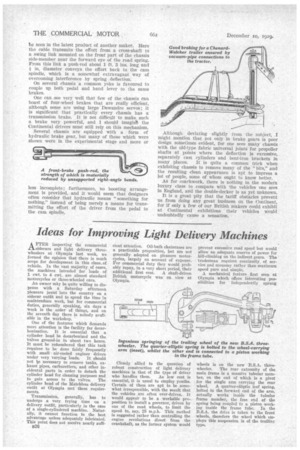Ideas for Improving Light Delivery Machines
Page 62

If you've noticed an error in this article please click here to report it so we can fix it.
A' EA inspecting the commercial sidecars and light delivery threewheelers at Olympia last week, we formed the opinion that there is much scope for development in this class-of vehicle. In the vast majority of cases, the machines intended for loads of 1 cwt. to 4 cwt. are almost standard motorcycles or three-wheeled cars.
An owner may be quite willing to dispense with a Saturday afternoon pleasure jaunt into the country on a sidecar outfit and to spend the time in maintenence work, but for commercial duties, generally speaking, six days a week is the order of things, and on the seventh day there is nobody available in the workshop.
One of the features which demands more attention is the facility for decarbonization. It is essential that a cylinder head be decarbonized and the valves ground-in in about two hours. It must be refnembered that this task requires to be done fairly frequently with small air-cooled engines driven
under very varying loads. It should not Ile necessary to remove tanks, exhaust pipes, carburetters, and other incidental parts in order to detach the cylinder head for cleaning purposes and to gain access to the valves. The cylinder head of the Matchless delivery outfit at Olympia met these requirements.
Transmission, generally, has to undergo a very, trying time on a delivery outfit, particularly in the case of a single-cylindered machine. Naturally, it cannot function to the best advantage unless adequately lubricated. This point does not receive nearly suf5
B26
cleat attention. Oil-bath ehaincases arc a practicable proposition, but are not generally adopted on pleasure motorcycles, largely on account of expense. For commercial duty they would probably repay, in a very short period, their additional first cost. A shaft-driven British motorcycle was on view at Olympia.
Closely allied to the question of robust construction of light delivery machines is that of the type of driver
who handles them. As low cost is essential, it is usual to employ youths. Certain of them are apt to be somewhat irresponsible, with the vesult that the vehicles are often over-driven. It would appear to be a workable proposition to install a governor, driven by one of the road wheels, to limit the speed to, say, 25 m.p.h. This method is suggested rather than controlling the engine revolutions direct from the crankshaft, as the former system would
prevent excessive road speed but would allow an adequate reserve of power for hill-climbing on the indirect gears. The tradesman requires continuity, . of service and economy rather than maximum speed pure and simple.
A mechanical feature first seen at Olympia which offers interesting possibilities for independently sprung wheels is on the new -B.S.A. three
wheeler. The rear extremity of the main frame is a massive tubular member, on the end of which is a pivot for the single arm carrying the rear wheel. A quarter-elliptic leaf spring, bolted to the forward end of the arm, actually works inside the tubular frame member, the free end of the spring being coupled to a piston working inside the frame tube. In the B.S.A. the drive is taken to the front wheels, therefore the wheel which employs this suspension is of the trailing type.
























































































































